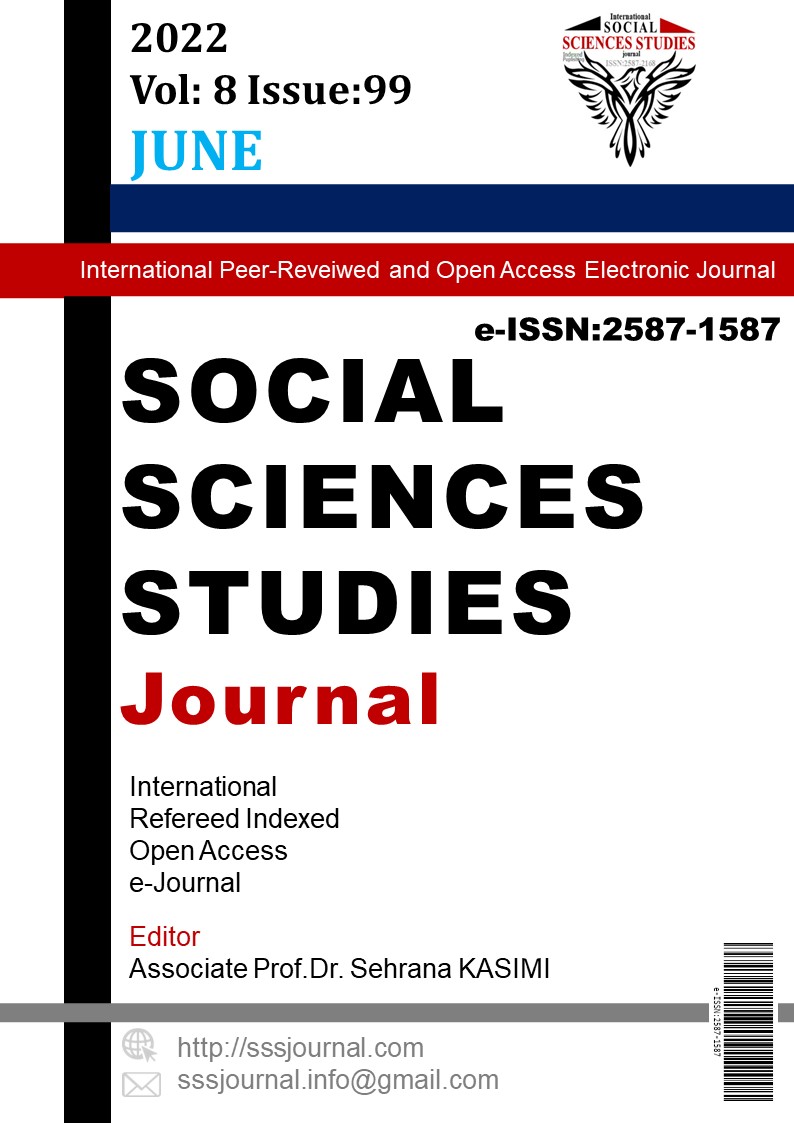Author :
Abstract
Eski Türkçe ile ilgili alanyazında {-(X)D-} biçimbirimi, eylemden eylem türeten bir kuvvetlendirme veya pekiştirmeli çatı eki olarak tanımlanmıştır. Ne var ki kuvvetlendirme ve pekiştirme terimleri bir işlevi anlatsa da herhangi bir dilbilgisel ulama gönderimde bulunmamaktadır. Eldeki en eski metinlerin sezdirimleriyle Eski Türkçe döneminden önce tabanlara bitmişlik görünüşü işleviyle eklendiğini varsaydığımız {-(X)D-} eki zamanla sözdizimsel özelliklerini kaybederek eylem tabanına kaynaşmıştır. Bunun sonucunda dilbilgiselden sözlüksele yani görünüşten kılınışa doğru bir kayma süreci gerçekleşmiştir. Bu çalışmanın kuramsal çerçevesini oluşturan Smith’in (1997) durum türleri yaklaşımına göre ele alındığında {-(X)D-} ekinin [+devinim], [+ereklik] ve [-sürerlik] özellikleriyle erişme kılınışını yansıttığı anlaşılmaktadır. Tarihsel süreçte [±bitmişlik] değiştirgeni odağında {-(X)D-} ile {-n-}/ {-l-} eklerinin bir arada ele alınması gerektiği bu çalışmada ulaşılan bir başka çıkarımdır. {-(X)D-} [+bitmişlik], {-n-}/ {-l-} ise [-bitmişlik] görünüşü ile birbirine karşıt bir örüntü oluşturarak tarihsel serüvenlerine başlamışlardır. Bu karşıtlığın etkisi kılınış ve çatı ulamlarının bünyesinde Eski Türkçe döneminden günümüze kadar sürmüştür. Eylemden yine eylem tabanı oluşturan {-(X)k-} ekinin {-(X)D-} ile hem tarihsel süreç hem de kılınış açısından benzer yönler taşıdığı gözlemi bu çalışmada ileri bir araştırma önerisi olarak sunulmuştur.
Keywords
Abstract
In the literature on Old Turkic, the morpheme of {-(X)D-} was defined as a form of deverbal reinforcement or an emphatic voice suffix. However, although the terms reinforcement and emphasis express a function, they do not refer to any linguistic appendix. The affix {-(X)D-}, which was assumed based on the implications of the oldest texts available to be added to bases with the function of perfective aspect prior to the Old Turkic period, lost its syntactic features over time and fused with the base verb. As a result of this, a transition process from grammatical to lexical, meaning from the grammatical aspect to the lexical aspect, occurred. When this is considered in line with the situation types approach of Smith (1997), which constitutes the conceptual framework of the present study, it is understood that the affix of {-(X)D-} reflects the lexical aspect of achievement with its features [+dynamic], [+telic] and [-durative]. Another inference made in the present study is that in the historical process, it is necessary to discuss the affixes {-(X)D-} and {-n-}/ {-l-} in conjunction based on the [±perfective] aspect. {-(X)D-} and {-n-}/ {-l-} started their historical journey by forming a contrasting pattern with the former constituting [+perfective] and the latter constituting [-perfective]. The impact of this contrast was maintained from the Old Turkic period to date within the scope of actionality and voice categories. In the present study, the observation that the deverbal affix {-(X)k-}, carries similar aspects to{-(X)D-} in terms of both the historical process and actionality has been presented as a research proposal in the present study.
Keywords
- Akar, A. (2010). Türk Dili Tarihi, Ötüken Neşriyat, İstanbul.
- Akar, A. (2010). Türk Dili Tarihi, Ötüken Neşriyat, İstanbul.
- Ata, A. (1997). Nâṣırü’d-dîn bin Burhânü’d-dîn Rabgûzî: Kıṣaṣü’l-Enbiyâ (Peygamber Kıssaları), Türk Dil Kurumu, Ankara.
- Ata, A. ve Tulum, M. M. (2011). Uygur Türkçesi (ed. Gürer Gülsevin ve Mehmet. M. Tulum), Anadolu Üniversitesi Yayınları, Eskişehir.
- Biber, D. (1989). “A Typology of English Texts”, Linguistics, 27: 3-43.
- Bussmann, H. (1996). Routledge Dictionary of Language and Linguistics, Routledge, London and New York. Caferoğlu, A. (1968). Eski Uygur Türkçesi Sözlüğü, Türk Dil Kurumu, Ankara.
- Caferoğlu, A. (1984). Türk Dili Tarihi, Enderun Kitabevi, İstanbul.
- Comrie, B. (1976). Aspect, Cambridge University Press, Cambridge.
- Doğru, F. (2020). “Kılınış”, Türkçede Dilbilgisel Ulamlar (ed. Erdoğan Boz), ss. 3-34, Gazi Kitabevi, Ankara. Ercilasun, A.B. (2004). Başlangıçtan Yirminci Yüzyıla Türk Dili Tarihi, Akçağ, Ankara.
- Erdal, M. (1991). Old Turkic Word Formation: A Functional Approach to the Lexicon (Vol. II), Otto Harrassowitz, Wiesbaden.
- Erdal, M. (2004). A Grammar of Old Turkic, Brill, Leiden, Boston.
- Erdem, M. (2000). “Historical Development of Reflexive, Reciprocal, Causative and Passive in Turkish”, Doktora Tezi, The University of Manchester, Manchester.
- Gabain, A. von (1995). Eski Türkçenin Grameri (çev. Mehmet Akalın), Türk Dil Kurumu, Ankara.
- Gedik, S. (2009). Türk Dilinin Tarihi Gelişimi. Üniversiteler için Türk Dili Elkitabı (ed. Mustafa Durmuş), Grafiker Yayınları, Ankara.
- Güven, M. (2012). “On the Linguistic Realization of Situation Types in Turkish”, Trakya Üniversitesi Sosyal Bilimler Dergisi, Cilt 14, Sayı 1: 177-194.
- Hamilton, R.J. (1998). Budacı İyi ve Kötü Kalpli Prens Masalının Uygurcası –Kalyanamkara ve Papamkara- (çev. Ece Korkut ve İsmet Birkan), Simurg, Ankara.
- Hirik, E. (2016). “-(X)k Ekinin Kılınış, Kiplik ve Çatı Kategorisindeki İşlevleri”, Türkbilig, Sayı 32: 97-114.
- Karamanlıoğlu, A.F. (1989). Seyf-i Serâyî: Gülistan Tercümesi (Kitâb Gülistan bi’t-Türkî), Türk Dil Kurumu, Ankara.
- McEnery, T.; Xiao, R.; Yukio, T. (2006). Corpus-based Language Studies: An Advanced Resource Book, Routledge, New York.
- Sebzecioğlu, T. (2008). “Türkçede Edilgenlik”, Doktora Tezi, Dokuz Eylül Üniversitesi, İzmir.
- Shirai, Y. ve Li, P. (2000). The Acquisition of Lexical and Grammatical Aspect, Mouton de Gruyter, Berlin, New York.
- Smith, C. (1997). The Parameter of Aspect (Second Edition), Kluwer Academic Publishers, Dordrecht. Şen, S. (2015). Eski Uygur Türkçesi Dersleri, Kesit Yayınları, İstanbul.
- Şirin, H. (2015). Kül Tigin Yazıtı, Bilge Kültür Sanat, İstanbul.
- Tan, A. (2010). Kırgız Türkçesinde Tasvir Fiilleri, Türk Dil Kurumu, Ankara.
- Tekin, Ş. (1976). Uygurca Metinler II: Maytrısimit, Atatürk Üniversitesi, Erzurum.
- Tekin, T. (1998). Orhon Yazıtları (Kül Tigin, Bilge Kağan, Tunyukuk), Simurg, İstanbul.
- Tekin, T. (2003). Orhon Türkçesi Grameri (Yayımlayan: Mehmet Ölmez) Türk Dilleri Araştırmaları Dizisi: 9, Kitap Matbaası, İstanbul.
- Tekin, T ve Ölmez, M. (1999). Türk Dilleri (Giriş), Simurg, İstanbul.
- Tognini-Bonelli, E. (2001). Corpus Linguistics at Work: Studies in Corpus Linguistics), John Benjamins, Amsterdam.
- Toparlı, R. (1992). İrşâdü’l-Mülûk ve’s-selâtin, Türk Dil Kurumu, Ankara.
- Vendler, Z. (1967). Linguistics in Philosophy, Cornell University Press, Cornell.Verbitsky, V.İ. (1870). Slovar Aladagskogo Nareçiy Tyurkskogo Yazıka, Kazan.
- Walker, J. A. (2010). Introduction. Aspect in Grammatical Variation (ed. James Anthony Walker), John Benjamins Publishing Company, Amsterdam, Philadelphia.





